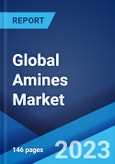The global amines market size reached US$ 19.5 Billion in 2022. Looking forward, the market is expected to reach US$ 26.4 Billion by 2028, exhibiting a growth rate (CAGR) of 5.18% during 2022-2028.
Amines are colorless, less volatile organic compounds that belong to the family of nitrogen. They are made by replacing oxygen with hydrogen atoms in the molecule or reaction of ammonia with organic groups. They are widely used as corrosion inhibitors and in the production of rubber, fibers, synthetic resins, and azo dyes. Besides this, they are also employed in gas treatment for removing carbon dioxide (CO2) from natural gas and the manufacturing of various drugs.
2. What is the expected growth rate of the global amines market during 2023-2028?
3. What has been the impact of COVID-19 on the global amines market?
4. What are the key factors driving the global amines market?
5. What is the breakup of the global amines market based on product?
6. What is the breakup of the global amines market based on the function?
7. What is the breakup of the global amines market based on the application?
8. What are the key regions in the global amines market?
9. Who are the key players/companies in the global amines market?
Amines are colorless, less volatile organic compounds that belong to the family of nitrogen. They are made by replacing oxygen with hydrogen atoms in the molecule or reaction of ammonia with organic groups. They are widely used as corrosion inhibitors and in the production of rubber, fibers, synthetic resins, and azo dyes. Besides this, they are also employed in gas treatment for removing carbon dioxide (CO2) from natural gas and the manufacturing of various drugs.
Amines Market Trends
The vast applications of amines in different end use industries represent one of the key factors bolstering the market growth. For instance, they find application in the agriculture sector to formulate chemicals for crop protection. Moreover, due to inflating income levels, improving living standards, and the rising influence of social media, the demand for personal care products is increasing worldwide, which, in turn, is influencing the market. Amines are also used to produce plastics, emulsifiers, chelating agents, corrosion inhibitors, and concentrated detergents. This, along with significant growth in the construction, energy, and industrial sectors, is strengthening the market. Apart from this, the growing prevalence of chronic diseases, such as diabetes, hypertension, and cholesterol, is positively influencing the use of amines in the pharmaceutical industry. They are also gaining traction as solvents for manufacturing paint and coatings in the automotive industry. Furthermore, increasing investments in research and development (R&D) activities to improve their characteristics and expand their uses are anticipated to propel the growth of the market.Key Market Segmentation
This research provides an analysis of the key trends in each sub-segment of the global amines market report, along with forecasts at the global, regional and country level from 2023-2028. The report has categorized the market based on product, function and application.Breakup by Product:
- Ethanolamines
- Fatty Amines
- Alkylamines
Breakup by Function:
- Solvent
- Chelating Agent
- Corrosion Inhibitor
- Bleach Activators
- Surfactants
Breakup by Application:
- Agriculture
- Gas Treatment
- Petroleum
- Water Treatment
- Personal Care
- Paints and Coatings
Breakup by Region:
- North America
- United States
- Canada
- Asia-Pacific
- China
- Japan
- India
- South Korea
- Australia
- Indonesia
- Europe
- Germany
- France
- United Kingdom
- Italy
- Spain
- Russia
- Latin America
- Brazil
- Mexico
- Middle East and Africa
Competitive Landscape
The competitive landscape of the industry has also been examined along with the profiles of the key players being Akzo Nobel N.V., Arkema S.A., BASF SE, Celanese Corporation, Dow Inc., DuPont de Nemours Inc., Huntsman Corporation, Lanxess AG, LyondellBasell Industries N.V., Mitsubishi Gas Chemical Company Inc., SABIC and Solvay S.A.Key Questions Answered in This Report
1. What was the size of the global amines market in 2022?2. What is the expected growth rate of the global amines market during 2023-2028?
3. What has been the impact of COVID-19 on the global amines market?
4. What are the key factors driving the global amines market?
5. What is the breakup of the global amines market based on product?
6. What is the breakup of the global amines market based on the function?
7. What is the breakup of the global amines market based on the application?
8. What are the key regions in the global amines market?
9. Who are the key players/companies in the global amines market?
Table of Contents
1 Preface3 Executive Summary11 Value Chain Analysis13 Price Analysis
2 Scope and Methodology
4 Introduction
5 Global Amines Market
6 Market Breakup by Product
7 Market Breakup by Function
8 Market Breakup by Application
9 Market Breakup by Region
10 SWOT Analysis
12 Porters Five Forces Analysis
14 Competitive Landscape
Companies Mentioned
- Akzo Nobel N.V.
- Arkema S.A.
- BASF SE
- Celanese Corporation
- Dow Inc.
- DuPont de Nemours Inc.
- Huntsman Corporation
- Lanxess AG
- LyondellBasell Industries N.V.
- Mitsubishi Gas Chemical Company Inc.
- SABIC
- Solvay S.A.
Methodology

LOADING...
Table Information
| Report Attribute | Details |
|---|---|
| No. of Pages | 146 |
| Published | November 2023 |
| Forecast Period | 2022 - 2028 |
| Estimated Market Value ( USD | $ 19.5 Billion |
| Forecasted Market Value ( USD | $ 26.4 Billion |
| Compound Annual Growth Rate | 5.2% |
| Regions Covered | Global |
| No. of Companies Mentioned | 12 |









